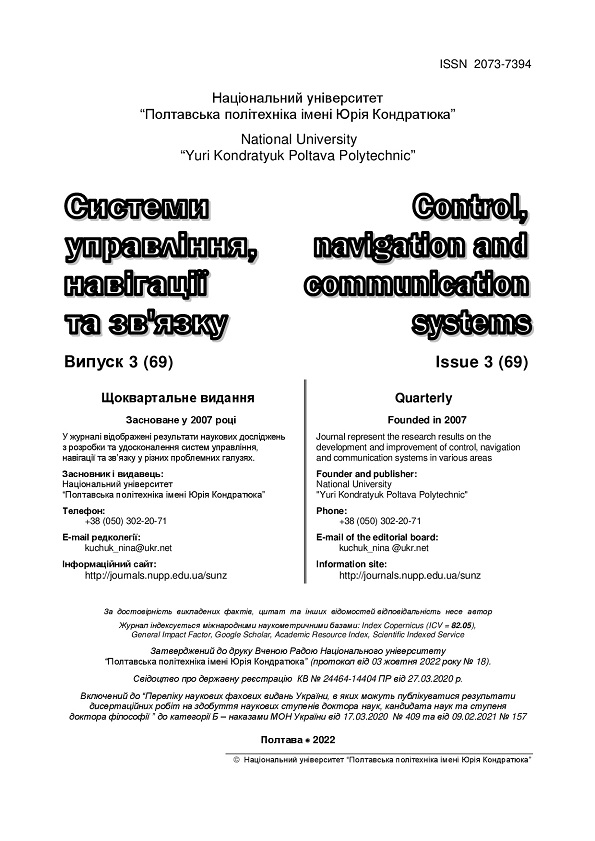TECHNICAL IMPLEMENTATION OF THE HYDRAULIC REGULATOR GROUNDWATER LEVEL
DOI:
https://doi.org/10.26906/SUNZ.2022.3.036Keywords:
hydraulic double-acting regulator, regulating well, solenoid valve, collector, drainage drain, microprocessor regulatorAbstract
The problem of moisture management of crops around the world is extremely important. The transformation of agricultural production into a highly developed sector of the economy is impossible without reducing its dependence on adverse climatic conditions by conducting irrigated agriculture in areas of insufficient and unstable moisture. Irrigated agriculture is an important component of crop production, a stabilizing factor in food and resource security of the state, especially in years with adverse weather conditions. Depending on climatic conditions, relief, depth of groundwater, different types of irrigation are used: drip irrigation, sprinkling, irrigation in strips and furrows, subsoil. In areas with excessive moisture, drainage systems are used to reduce soil moisture to the level required for crops. In areas with a depth of groundwater up to 1.5 … 2 m and flat terrain, groundwater moisture is widely used. Examples are the western and central parts of Ukraine. Drained lands in Ukraine make up 3.2 million hectares, almost 70% of them have closed drainage, and 1.1 million hectares have bilateral water regulation. At present, the technical condition of in-house drainage systems needs to be improved through modernization and radical reconstruction. In addition, due to the unsatisfactory technical condition of the reclamation network in dry years, not the entire area is used for the purpose of the bilateral system. There is a need to restore the effective functioning of existing reclamation systems on drained lands, which is not fully provided by using a manual mode of soil moisture regulation. Existing water regulation tools need to be improved in order to improve the accuracy of water level regulation, take into account the impact of accidental external disturbances, provide resource-saving irrigation regimes for agricultural plants in conditions of shortage of water and energy resources, which will create conditions for efficient agriculture.Downloads
References
Матус С.К. Удосконалення водорегулювання на автоматизованих осушувально-зволожувальних системах з урахуванням рельєфної диференціації території: дис. канд. техн. наук: 06.01.02 / С.К. Матус – Рівне, 2013. – 208 с.
Наумчук О.М. Удосконалення процесів водорегулювання на осушувально-зволожувальних системах засобами гідравлічної автоматизації: дис. канд. техн. наук: 06.01.02 / О.М. Наумчук – Рівне, 2007. – 218 с.
Пастушенко В.Й. Автоматизована система керування вологозабезпеченістю сільськогосподарських культур прикрапельному зволоженні / В.Й. Пастушенко, А.М. Стеценко // Автоматизовані системи управління та прилади автоматики. – Харків, ХНУРЕ, 2009. – Випуск 147. – С. 46 – 52.
Пастушенко В.Й. Автоматизовані системи керування вологозабезпеченістю сільськогосподарських культур при підґрунтовому та крапельному зрошенні та їх технічна реалізація // В.Й. Пастушенко, А.М. Стеценко // XVI Міжнародна конференція з автоматичного управління «Автоматика-2009». Тези доповідей. – Чернівці, 22 – 25 вересня 2009. – C. 202 – 204.
Пастушенко В.Й. Програмне та технічне забезпечення автоматизованої системи керування вологозабезпеченістю сільськогосподарських культур на меліоративних системах двосторонньої дії. / В.Й. Пастушенко, А.М. Стеценко // XVII Міжнародна конференція з автоматичного управління «Автоматика-2010». Тези доповідей. Том 1. – Харків, 27 – 29 вересня 2010. – C. 264 – 267.
Пастушенко В.Й. Автоматизація процесу керування вологозабезпеченістю сільськогосподарських культур при підґрунтовому зволоженні на меліоративних системах двосторонньої дії / В.Й. Пастушенко, А.М. Стеценко // XVIII Міжнародна конференція з автоматичного управління «Автоматика-2011». Матеріали конференції. – 28 – 30 вересня 2011 року, Львів. – C. 107 – 108.




